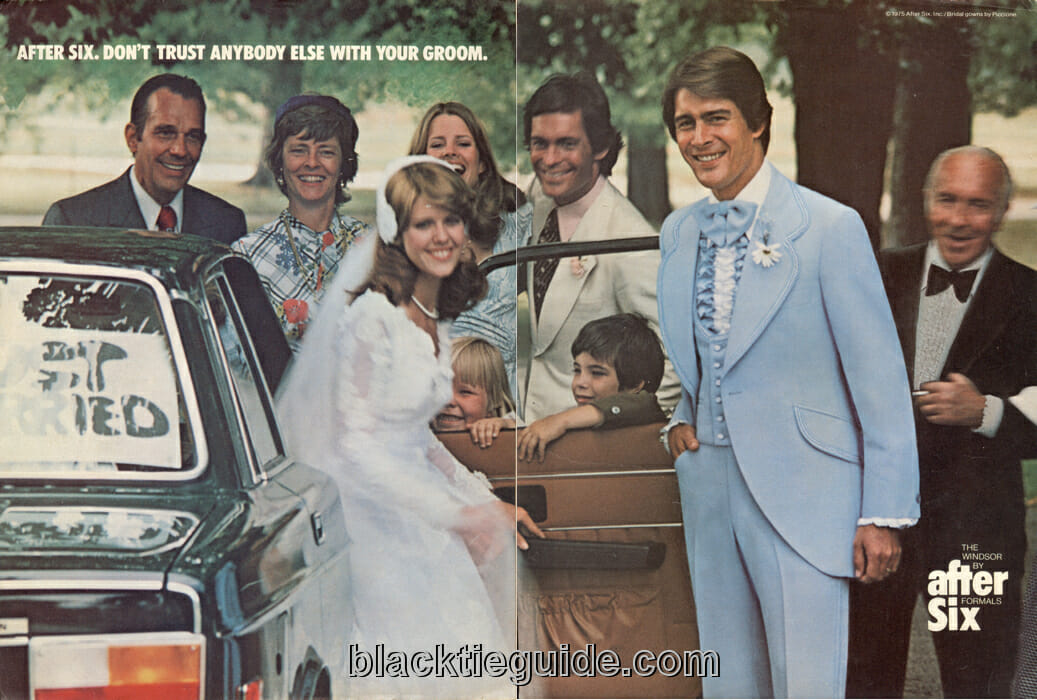When researching the tuxedo’s history for the Guide I thoroughly enjoyed reviewing vintage menswear magazines and observing the tuxedo’s elegant evolution through the decades. However, once I got to the late 1950s the research became somewhat nausea-inducing.

Each year the formalwear pictorials and advertisements featured progressively more awful tuxedo separates (ostensibly for summer or less formal occasions) beginning with simple patterns and subdued colors then devolving into dizzying decorations, obnoxious hues and modern synthetic fibers. The only redeeming factor during this period of research was the anticipation of the debut of history’s most infamous “formal” garment: the colored tuxedo suit. The anticipation grew as I advanced from the 1960s into the 1970s but then turned to puzzlement as I progressed through the decade’s GQ and Esquire issues without a single sighting.
How could that be? How could the iconic powder-blue suit or any of its kitschy cousins that were so prevalent in ‘70s prom and wedding photos not appear once in the hundreds of tuxedo ads and articles found in those leading menswear magazines? The answer seems to be that the aberrations of the ‘50s and ‘60s set the stage for the formalwear market to split into two very different categories by the start of the disco era.
The formal suits appearing in the men’s periodicals were generally conservative and targeted towards sophisticated, mature guys who preferred to purchase their formal wear. The trendy and unorthodox colored tuxedos, tailcoats and cutaways, on the other hand, were clearly intended for naïve youth who dominated the market for prom and wedding rentals. Modern photos of these novelty garments reveal sloppy workmanship indicative of mass production and industrial-strength polyester indicative of durability required for frequent use.
As the rental demographic was not likely to be reading GQ or Esquire I have long suspected the corresponding tuxedo models were marketed either in-store or in periodicals aimed specifically at that consumer group. This theory was bolstered by a recent discovery of a 1975 ad for a bona fide powder-blue tuxedo, the first in the history of my research. Sure enough, it came from a bridal magazine.

Wow! That is disgusting. I think it is called the windsor because it is a take-off of a Mourning Coat. At least they have the sense to display it at a daytime wedding.
N
Is that Priscilla Presley?
Nope. Hint: It’s not Mork either.
Yes, you were not kidding… I really did feel nauseated… As if my looking at this powder blue “tux” with what seems like “industrial strength” contours and powder blue paint befitting of a ’52 Packard was some vertigo-inducing optical illusion… really! :^)
And for the bonus points, the ‘bride’ in the ad must be actress Pam Dawber who played Mindy to Robin Williams’ Mork in the 1978 ~ 1982 television sitcom “Mork and Mindy” but I confess I had to look it up. Although I watched the show occasionally, have since then followed and greatly enjoyed Robin Williams’ career as a comedian and actor and can readily recognize his photo, I never would have guessed who the heck played Mindy, a factoid shelved in the obscure ‘stacks section’ of my mind. So thank you much for the hint!
You’re right. Congratulations!
can idea where I can rent a powder blue retro tuxedo?